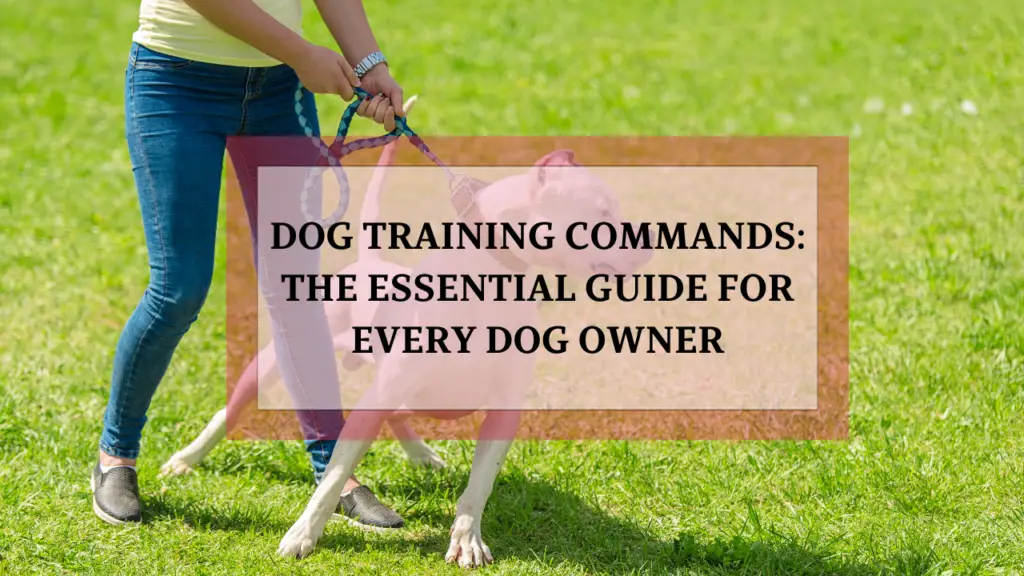training your dog is one of the most important responsibilities of a pet owner. A well-trained dog is not only happier and more obedient but also safer and easier to manage in daily life. Teaching dog training commands helps establish clear communication between you and your furry companion, reducing unwanted behaviors and reinforcing good habits.
In this guide, we’ll cover:
✅ Basic dog training commands every dog should know
✅ Advanced commands for improved obedience
✅ Hand signals to enhance communication
✅ Training tips and troubleshooting
By the end, you’ll have all the tools needed to train your dog effectively. Let’s dive in!
Basic Dog Training Commands Every Dog Should Know
These fundamental commands form the foundation of obedience training. Every dog should master them to ensure good behavior and safety.
1. Sit
The “sit” command is often the first a dog learns, as it’s simple and useful in many situations.
How to Teach “Sit”
- Hold a treat near your dog’s nose.
- Move your hand upward so their head follows, causing their bottom to lower naturally.
- Once they sit, say “sit”, give them a treat, and praise them enthusiastically.
- Repeat several times in short training sessions.
Common Mistakes:
❌ Forcing them into position – This can confuse or scare them.
❌ Not rewarding immediately – Delayed rewards make learning harder.
2. Stay
A solid “stay” command helps keep your dog under control, preventing dangerous situations.
How to Train “Stay”
- Have your dog sit first.
- Hold out your palm and say “stay.”
- Step back slightly; if they stay, return and reward them.
- Increase distance gradually over multiple sessions.
Pro Tip:
✔️ Always use a release word like “okay” to signal they can move again.
3. Come (Recall Command)
A strong “come” command is crucial for safety, especially in off-leash situations.
How to Teach “Come”
- Attach a long leash to your dog.
- Get down to their level and say “come” in a cheerful voice.
- Gently pull the leash if needed.
- When they come to you, reward with praise and treats.
❌ Don’t use “come” for punishment – This creates negative associations!
4. Down (Lie Down)
The “down” command is excellent for calming energetic dogs.
Training Steps:
- Hold a treat near their nose.
- Move your hand down to the floor so they follow.
- Once they lie down, say “down” and reward them.
Some dogs resist this command, so try training in a quiet space with few distractions.
5. Leave It
The “leave it” command prevents dogs from picking up harmful or unwanted objects.
How to Teach “Leave It”
- Hold a treat in your fist.
- Let your dog sniff; when they stop, say “leave it” and reward them.
- Practice with different objects to reinforce the behavior.
🚨 This command is essential for preventing dogs from eating toxic foods!
Advanced Dog Training Commands
Once your dog has mastered the basics, you can move on to more advanced commands to improve obedience and mental stimulation.
6. Heel
The “heel” command teaches dogs to walk beside you without pulling on the leash.
How to Train “Heel”
- Start with your dog on a leash, standing beside you.
- Hold a treat near your thigh and start walking.
- Say “heel” as you move. Reward when they stay beside you.
- Gradually increase the duration before rewarding.
7. Wait
The “wait” command is useful for doorways and crossings, keeping your dog safe.
Steps to Train “Wait”
- Hold out your palm like a stop sign.
- Say “wait” before opening a door.
- If they stay, reward them.
- Gradually increase wait time before allowing them to proceed.
8. Quiet
Does your dog bark excessively? The “quiet” command helps control barking.
How to Train “Quiet”
- When your dog barks, say “quiet” in a calm voice.
- Once they stop, reward them.
- Be consistent and patient—this takes time!
Hand Signals for Dog Training Commands
Using hand signals alongside verbal commands improves communication. Here are common ones:
| Command | Hand Signal |
|---|---|
| Sit | Raise hand with palm up |
| Stay | Hold palm out like a stop sign |
| Down | Move hand downward |
| Come | Wave hand toward your chest |
Hand signals are great for deaf dogs or those in noisy environments!
Positive Reinforcement: The Best Training Method
✅ Reward-based training is scientifically proven to be the most effective way to train dogs.
🔹 Why Positive Reinforcement Works:
- Encourages dogs to repeat good behaviors
- Strengthens the bond between you and your dog
- Makes learning enjoyable
Examples of Rewards:
✔️ Treats
✔️ Praise
✔️ Toys
✔️ Playtime
❌ Avoid punishment-based training, as it can lead to fear and anxiety.
Common Dog Training Mistakes (And How to Fix Them!)
🚨 Many dog owners accidentally reinforce bad behaviors. Here’s how to avoid common training mistakes:
| Mistake | Solution |
|---|---|
| Repeating commands | Say the command once and wait for a response. |
| Inconsistent training | Train daily, even for a few minutes. |
| Using punishment | Stick to positive reinforcement for better results. |
| Lack of patience | Training takes time—be consistent and encouraging! |
Final Thoughts
Training your dog with consistent commands, positive reinforcement, and patience will lead to a well-behaved and obedient companion. Whether you’re working on basic dog training commands or teaching advanced tricks, the key is practice, repetition, and making training fun for both you and your dog.

Hi, I’m Ali Tarek, the founder of Animalsman. I’ve always been passionate about pets, especially dogs and cats, and I created this website to share practical tips, easy recipes, and helpful care advice for fellow pet lovers. My goal is to make pet care simple, enjoyable, and accessible for everyone. When I’m not writing or curating content, you’ll usually find me spending time with my furry friends or learning new ways to keep them happy and healthy.



